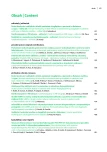Insulin application techniques in adult patients with diabetes
Authors:
Tomáš Pelcl; Martin Prázný
Authors‘ workplace:
III. interní klinika – klinika endokrinologie a metabolizmu 1. LF UK a VFN v Praze
Published in:
Vnitř Lék 2016; 62(6): 486-490
Category:
Reviews
Overview
Treatment of diabetes mellitus with insulin is associated with a large number of subcutaneous injections. Incorrect insulin application technique can lead to complications both local (lipohypertrophy, scars) and systemic (high variability of insulin absorption and action, unexpected hypoglycemia or hyperglycemia, suboptimal overall glucose control). Regarding insulin application, we need to pay particular attention to the risk of intramuscular application and consequent less expectable insulin effect. The risk of accidental intramuscular administration of insulin is reduced when shorter 4 mm insulin pen needles are used. Repeated application of insulin in the same locations may cause changes in the subcutaneous tissue (lipohypertrophy, inflammation). Application sites should be examined during routine checks at diabetes clinics. Patients should also be repeatedly advised to rotate the injection sites as a prevention of lipohypertrophy formation and not to inject any more injections into pathologically changed subcutaneous tissue. At the same time, patients should be advised that their total insulin dose may be decreased, and that they are temporarily at higher risk of hypoglycemia, if they switch injecting from lipohypertrophy changed tissue into healthy tissue.
Key words:
glucose variability – insulin application – lipohypertrophy – needles
Sources
1. Heinemann L. Variability of Insulin Action: Does It Matter? Insulin 2008; 3(1): 37–45.
2. Frid A, Linde B. Intraregional differences in the absorption of unmodified insulin from the abdominal wall. Diabet Med 1992; 9(3): 236–239.
3. Frid A, Gunnarson R, Gunter P et al. Effects of accidental intramuscular injection on insulin absorption in IDDM. Diabetes Care 1988; 11(1): 41–45.
4. Rave K, Heise T, Weyer C et al. Intramuscular versus subcutaneous injection of soluble and lispro insulins: Comparison of metabolic effects in healthy subjects. Diabet Med 1998; 15(9): 747–751.
5. Henriksen JE, Vaag A, Hansen IR et al. Absorption of NPH (isophane) insulin in resting diabetic patients; evidence for subcutaneous injection in the thigh as preferred site. Diabetic Medicine 1991; 8(5): 453–457.
6. Henriksen JE, Djurhuus MS, Vaag A et al. Impact of injection sites for soluble insulin on glycaemic control in type 1 (insulin-dependent) diabetic patients treated with a multiple insulin injection regimen. Diabetologia 1993; 36(8): 752–758.
7. Berard L, Desrochers F, Hagerty D et al. FIT Forum for Injection Technique Canada. Recommendations for Best Practice in Injection Technique. 2nd edition 2011. Dostupné z WWW: <http://www.fit4diabetes.com/files/5314/2071/1987/FIT_Recommendations_Page_View_En.pdf>.
8. Mudaliar SR, Lindberg FA, Joyce M et al. Insulin aspart (B28 asp-insulin): a fast-acting analog of human insulin: absorption kinetics and action profile compared with regular human insulin in healthy nondiabetic subjects. Diabetes Care 1999; 22(9): 1501–1506.
9. Owens DR, Coates PA, Luzio SD et al. Pharmacokinetics of 125I-labeled insulin glargine (HOE 901) in healthy men: comparison with NPH insulin and the influence of different subcutaneous injection sites. Diabetes Care 2000; 23(6): 813–819.
10. Gibney M, Arce C, Byron K et al. Skin and subcutaneous adipose layer thickness in adults with diabetes at sites used for insulin injections: implications for needle length recommendations. Curr Med Res Opin 2010; 26(6): 1519–1530.
11. Birkbaek N, Solvig J, Hansen B et al. A 4 mm needle reduce the risk of intramuscular injections without increasing backflow to skin surface in lean diabetic children and adults. Diabetes Care 2008; 31(9): e65.Dostupné z DOI: <http://dx.doi.org/10.2337/dc08–0977>.
12. Bergenstal RM, Strock ES, Peremislov D et al. Safety and efficacy of insulin therapy delivered via a 4mm pen needle in obese patients with diabetes. Mayo Clin Proc 2015; 90(3): 329–338.
13. Caffrey RD. Diabetes under control: Are all Syringes created equal? Am J Nursing 2003; 103(6): 46–49.
14. Wittmann A, Köver J, Kralj N et al. Insulin leakage value in relation to pen needle length and administered dose after subcutaneous Injection. Diabetes Technol Ther 2010; 12(8): 587–590.
15. Jørgensen JT, Rømsing J, Rasmussen M et al. Pain assessment of subcutaneous injections. Ann Pharmacother 1996; 30(7–8): 729–732.
16. Svačina Š. Komu může být koncentrovaný prandiální inzulin prospěšný? Interní Med 2015; 17(2): 91–92.
17. Blanco M, Hernández MT, Strauss KW et al. Prevalence and risk factors of lipohypertrophy in insulin – injecting patients with diabetes. Diabetes Metab 2013; 39(5): 445–453.
18. Vardar B, Kizilci S. Incidence of lipohypertrophy in diabetic patients and a study of influencing factors. Diabetes Res Clin Pract 2007; 77(2): 231–236.
19. Hajheydari Z, Kashi Z, Akha O et al. Frequency of lipodystrophy induced by recombinant human insulin. Eur Rev Med Pharmacol Sci 2011; 15(10): 1196–1201.
20. Fujikura J, Fujimoto M, Yasue S et al. Insulin-induced lipohypertrophy: report of a case with histopathology. Endocr J 2005; 52(5): 623–628.
21. Johansson U, Amsberg S, Hannerz L et al. Impaired Absorption of insulin Aspart from Lipohypertrophic Injection Sites. Diabetes Care 2005; 28(8): 2025–2027.
22. Olšovský J. Kožní komplikace terapie diabetes mellitus. Vnitř Lék 2006; 52(5): 474–476.
23. Hardy KJ, Gill GV, Bryson JR. Severe Insulin-Induced Lipohypertrophy Successfully Treated by Liposuction. Diabetes Care 1993; 16(6): 929–930.
Labels
Diabetology Endocrinology Internal medicineArticle was published in
Internal Medicine

2016 Issue 6
Most read in this issue
- Sinus histiocytosis with massive lymphadenopathy: FDG-PET/CT documented partial remission after treatment with 2-chlorodeoxyadenosine
- Insulin application techniques in adult patients with diabetes
- Cardiomyopathy in MR image
- Percutaneous endoscopic gastrostomy: analysis of practice at the endoscopic center of tertiary medical care
